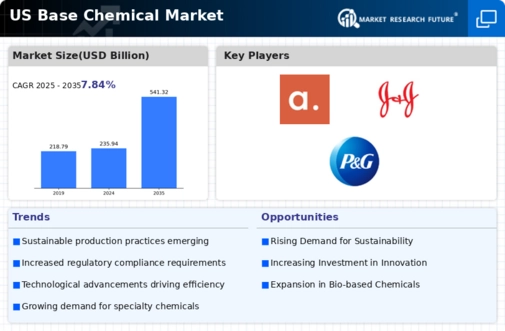Expansion of End-Use Industries
The base chemical market is significantly influenced by the expansion of various end-use industries, including automotive, construction, and consumer goods. As these sectors grow, they require a steady supply of base chemicals for production processes. For instance, the automotive industry alone is projected to consume over 30 million tons of base chemicals by 2026, driven by the demand for lightweight materials and advanced coatings. This increasing consumption is likely to bolster the market, as manufacturers strive to meet the rising needs of these industries. The interdependence between the base chemical market and its end-use sectors suggests a robust growth trajectory, potentially leading to increased investments and innovations.
Shifts in Raw Material Availability
The base chemical market is currently facing shifts in raw material availability, influenced by geopolitical factors and supply chain dynamics. Fluctuations in the prices of crude oil and natural gas, which are primary feedstocks for many base chemicals, can lead to volatility in production costs. In 2025, it is anticipated that the price of crude oil may stabilize around $70 per barrel, impacting the cost structure of the base chemical market. Additionally, the push for alternative feedstocks, such as bio-based materials, is gaining traction, potentially reshaping sourcing strategies. This evolving landscape necessitates that companies remain agile and responsive to changes in raw material availability to maintain their competitive edge.
Rising Demand for Eco-Friendly Products
The base chemical market is experiencing a notable shift towards eco-friendly products, driven by increasing consumer awareness and regulatory pressures. As industries strive to reduce their environmental footprint, the demand for sustainable chemicals is on the rise. In 2025, it is estimated that the market for bio-based chemicals could reach approximately $20 billion, reflecting a growth rate of around 15% annually. This trend is compelling manufacturers to innovate and adapt their production processes to meet the evolving preferences of consumers and regulatory bodies. Consequently, companies are investing in research and development to create greener alternatives, which is likely to reshape the competitive landscape of the base chemical market.
Technological Innovations in Production
Technological innovations are playing a pivotal role in transforming the base chemical market. Advances in production techniques, such as automation and process optimization, are enhancing efficiency and reducing costs. For example, the adoption of digital technologies is expected to improve production efficiency by up to 20% in the coming years. Furthermore, innovations in catalysis and bioprocessing are enabling the development of new chemical products with lower environmental impact. As these technologies become more prevalent, they are likely to drive competitiveness within the base chemical market, allowing companies to respond more effectively to market demands and regulatory challenges.
Regulatory Compliance and Safety Standards
The base chemical market is under constant scrutiny due to stringent regulatory compliance and safety standards imposed by government agencies. These regulations are designed to ensure the safe handling, production, and disposal of chemicals, which can significantly impact operational costs. Companies are compelled to invest in compliance measures, which may account for up to 10% of their operational budgets. As regulations evolve, particularly concerning environmental impact and worker safety, the industry must adapt swiftly to avoid penalties and maintain market access. This dynamic creates both challenges and opportunities for innovation within the base chemical market, as firms seek to develop safer and more compliant products.

















Leave a Comment